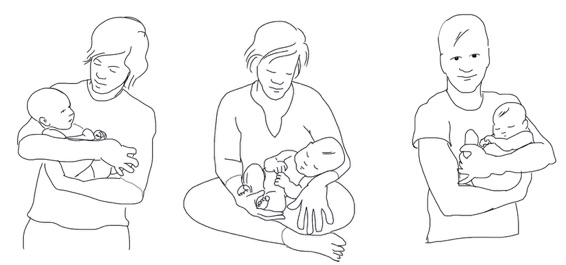This is the second of four in a series of companion articles and recorded zoom sessions. It is part of our Preparing for Caring Project to build awareness and educate about the importance of handling skills in caring for a baby. Read more about how these ideas play out in practical suggestions.

Having laid out our guiding principles of safety, orientation, comfort, bonding and curiosity in our previous post, we’ll now begin looking at the practical suggestions that follow from these principles.
At Babies Project, we often say that if we teach parents and caregivers nothing else in their first session, we teach them “baby ball,”1 a shorthand term for our recommended way of holding a baby. There’s a lot to unpack about baby ball – it encapsulates our principles, it’s relevant for babies of all ages, and it plays out both physically and metaphorically.
We’ll start by teasing out the bullets in our handout that we believe delineate the essential elements of baby ball.2
Legs gathered in, both arms in front, spine in flexion.
In more detail, we mean that a baby’s legs are flexed at their knee and hip joints and gathered into their body in such a way that it brings their lower spine into a C-curve, or flexion. Their head should be supported so it’s not falling back behind the rest of the spine, and so that the upper spine is in flexion. And finally, the baby’s arms should be in front and their hands freely available.
Why the flexed, curled in position? We believe it’s important to support a baby as they cycle between periods of rest and activity, internal and external attention, and flexion and extension. Flexion, internal attention and rest tend to go together as a baby cycles “in,” and extension, external attention and activity go along with cycling “out.”3
Most babies don’t need our help cycling out – the world is big, new and stimulating. They need us to notice and help them when it’s time to cycle back in – when they’re tired, upset, hungry, over-stimulated or startled. A small baby can’t always cycle in on their own – physically, cognitively or emotionally, and our support in helping them “find their way in” serves as a foundation for their eventual self-regulation, adaptability and resilience.
When a baby’s body is gathered into a coherent package, they can orient to themselves – they’re all here – more easily than if, for example, their body is extended, their legs are dangling, or an arm is unable to move.
Hold a baby more towards horizontal than vertical.
A key premise of developmental movement is that babies best learn to negotiate gravity and their own bodies by starting from a horizontal position, gradually finding their way up to vertical through their curiosity. In this process, their movement skills and perceptual abilities develop in relationship to each other: as they learn to push up higher from the floor, their visual and spatial world expands, and what they can newly perceive inspires new movement choices.
When we hold a baby more towards horizontal, we are meeting them where they are and respecting what their whole self can handle. When we overly impose (even accidentally) our adult verticality on them, their perceptual abilities may get ahead of what they can support in their movement, and it becomes more challenging for their movement and perceptual development to inform and support each other.
Provide support from underneath.
This idea is closely related to the previous one. Horizontal is ‘home base’ for a small baby, for whom gravity is a new experience. Horizontal offers a broad base of support from underneath that helps a baby (of any age) orient to the pull of gravity and the support of the earth. It helps them feel where ‘down’ is and gives them a sense of their own weight. It feeds a felt sense of safety and comfort that comes from yielding and bonding to gravity. And it familiarizes them with the primary source of resistance they will learn to push into in order to eventually get up to vertical.
When we hold and handle a baby from underneath, we help provide a sense of ground that is stable and orienting. When we hold a baby with parts of their body dangling in space, it’s difficult for them to feel and settle into our support.
Create a responsive container with your body and arms.
We are a baby’s environment when we hold and handle them – it’s a relational dance of container (us) and contents (baby). In offering a surrounding sense of touch and containment in baby ball, we help a baby feel safe and oriented – they feel and know themselves through meeting their container. And when the container we create is clear and at the same time responsive to their movements, a baby can settle into comfort.
What do we mean by a clear, responsive container? When we initially gather a baby into baby ball, they might express their ‘out’ state by pushing into the resistance of our container – this might include arching, kicking or extending their legs, and/or spreading their arms open. If our response to these movements is to completely give way and let go of our container, then the baby can’t feel our presence and can’t trust in the support of our container. Instead, we can respond to these outwardly-directed movements by giving way and still maintaining the container. In this way, our baby ball container can be womb-like – flexible, responsive and strong.
Inviting a baby who is ‘out’ to come into baby ball can be a process with its own mini-cycles of out and in. Meeting our clear, dynamic container can offer a resistance that helps a baby discharge their “out” energy and eventually settle into a quiet inward state.
As caregivers, finding a balance between flexibility and strength in shaping our baby ball containers can take practice, and it takes showing up to meet the baby we’re holding in the moment. Each baby is different, and each baby is always changing.
Bringing a baby into baby ball also asks the caregiver to co-regulate with the baby they’re holding. To create an enveloping, inviting container, a caregiver may need to modulate their own “out” state, to reconnect to the ground underneath them, and to find a supportive environment.
Support midline organization: hands together, forward focus.
“Finding” or “coming to midline” is an early, and in our view critical, developmental milestone, typically occurring when a baby is 3-4 months old. We say that a baby “has midline” when, lying on their back, they can volitionally bring their hands together, bring their hands to their mouth, orient their head to center, and gather their legs in. Coming to midline also includes convergence of the eyes, making binocular vision and depth perception possible.
Midline serves as a foundation for focused attention and further movement development, both symmetrical and asymmetrical. It underlies relation to self, and is an important resource to keep coming back to.
Offer a physical position to support calming, inward focus and quiet alertness.
This brings us back to the importance of supporting a baby’s rhythms and cycles. It also relates to the idea that we don’t need to teach babies to move; we need to help create the conditions for them to become curious, trusting that they will best learn from their curiosity and through their emerging agency. An important way we create those conditions is by supporting a baby to cycle back in to themselves, to settle into our support, to recuperate and integrate their previous experiences. When they’re ready to go back out, they can be more fully engaged and ready to learn.
In addition to the value of baby ball as a practical, physical way to support a baby, we believe baby ball also serves as a potent metaphor for parenting: how do we provide clear, responsive and kind containers (including boundaries, structure and routines) that allow a baby/child/teenager to feel met and to receive the support they need to find their way back out into the world?
Concluding thoughts
As always, what we teach about babies applies to humans at every stage of development. We adults also need to periodically turn away from the stimulation, demands and uncertainty of the world, and come back to ourselves for balance and recuperation. Like babies, we all need support to settle into.
We hope we’ve conveyed something of the richness of baby ball, and we hope you find these ideas engaging, whether you agree with them or not. Please share this with anyone who might be interested, and let us know what you think.
NOTES
1 To be clear, we didn’t come up with “baby ball” ourselves – we learned about it in our IDME training. All of these ideas, including baby ball, are based on the Body-Mind Centering® approach to Infant Developmental Movement Education (IDME), a program developed by Bonnie Bainbridge Cohen, with support from Sandra Jamrog and Lenore Grubinger, that teaches observation and facilitation of movement patterns in infants.
2 These suggestions are primarily focused on young infants in their first six months. The same principles, with variations, continue to apply after this stage as a baby’s movement and perceptual skills develop.
3 We’ve chosen to use the language of cycling in and out, rather than referring to specific nervous system-based states, which are a part of these cycles but not the whole story.
* * *

